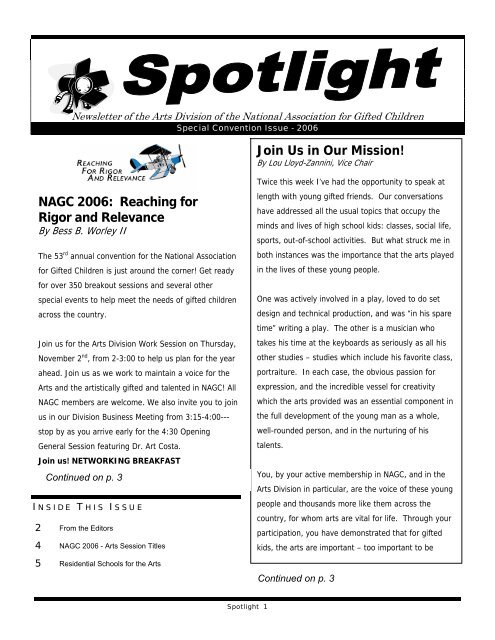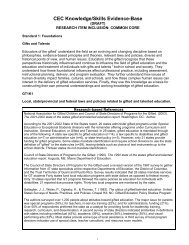Reaching for Rigor and Relevance - NAGC
Reaching for Rigor and Relevance - NAGC
Reaching for Rigor and Relevance - NAGC
Create successful ePaper yourself
Turn your PDF publications into a flip-book with our unique Google optimized e-Paper software.
Newsletter of the Arts Division of the National Association <strong>for</strong> Gifted ChildrenSpecial Convention Issue - 2006Join Us in Our Mission!By Lou Lloyd-Zannini, Vice Chair<strong>NAGC</strong> 2006: <strong>Reaching</strong> <strong>for</strong><strong>Rigor</strong> <strong>and</strong> <strong>Relevance</strong>By Bess B. Worley IIThe 53 rd annual convention <strong>for</strong> the National Association<strong>for</strong> Gifted Children is just around the corner! Get ready<strong>for</strong> over 350 breakout sessions <strong>and</strong> several otherspecial events to help meet the needs of gifted childrenacross the country.Join us <strong>for</strong> the Arts Division Work Session on Thursday,November 2 nd , from 2-3:00 to help us plan <strong>for</strong> the yearahead. Join us as we work to maintain a voice <strong>for</strong> theArts <strong>and</strong> the artistically gifted <strong>and</strong> talented in <strong>NAGC</strong>! All<strong>NAGC</strong> members are welcome. We also invite you to joinus in our Division Business Meeting from 3:15-4:00---stop by as you arrive early <strong>for</strong> the 4:30 OpeningGeneral Session featuring Dr. Art Costa.Join us! NETWORKING BREAKFASTContinued on p. 3I NSIDE T HIS I SSUE2 From the Editors4 <strong>NAGC</strong> 2006 - Arts Session Titles5 Residential Schools <strong>for</strong> the ArtsTwice this week I’ve had the opportunity to speak atlength with young gifted friends. Our conversationshave addressed all the usual topics that occupy theminds <strong>and</strong> lives of high school kids: classes, social life,sports, out-of-school activities. But what struck me inboth instances was the importance that the arts playedin the lives of these young people.One was actively involved in a play, loved to do setdesign <strong>and</strong> technical production, <strong>and</strong> was “in his sparetime” writing a play. The other is a musician whotakes his time at the keyboards as seriously as all hisother studies – studies which include his favorite class,portraiture. In each case, the obvious passion <strong>for</strong>expression, <strong>and</strong> the incredible vessel <strong>for</strong> creativitywhich the arts provided was an essential component inthe full development of the young man as a whole,well-rounded person, <strong>and</strong> in the nurturing of histalents.You, by your active membership in <strong>NAGC</strong>, <strong>and</strong> in theArts Division in particular, are the voice of these youngpeople <strong>and</strong> thous<strong>and</strong>s more like them across thecountry, <strong>for</strong> whom arts are vital <strong>for</strong> life. Through yourparticipation, you have demonstrated that <strong>for</strong> giftedkids, the arts are important – too important to beContinued on p. 3Spotlight 1
<strong>NAGC</strong> Continued from p. 1Friday, November 3, 7:30 – 8:30 amThis will be a great opportunity <strong>for</strong> you to networkwith other <strong>NAGC</strong> members over a light continentalbreakfast. The room will be set up in round tables<strong>and</strong> could be organized by division or topic usingtabletop signs. Look <strong>for</strong> others with your interests<strong>and</strong> share your ideas <strong>and</strong> experiences.VOLUNTEERS ARE NEEDED!!!!We need volunteers to support our division byhosting division sessions, introducing the speakers,<strong>and</strong> distributing <strong>and</strong> collecting the session evaluation<strong>for</strong>ms. If you see a division title that catches youreye, please consider serving as our Facilitator <strong>for</strong> thatsession. Contact me, Bess, at bebew2@yahoo.comASAP!Bess B. Worley II, Ph.D., is Chair of the Arts Divisionof <strong>NAGC</strong>. She is the Director of Gifted Education <strong>for</strong>Gloucester County Public Schools in Virginia whereshe also shares oversight of the visual <strong>and</strong>per<strong>for</strong>ming arts program in the district. Bess hastaught middle school choir, middle school generalmusic, elementary music, <strong>and</strong> has served as anelementary gifted education specialist. Herprofessional interests include gifted educationprograms <strong>and</strong> programs <strong>for</strong> developing talent in thevisual <strong>and</strong> per<strong>for</strong>ming arts, assessment of studentlearning, <strong>and</strong> instructional leadership.The greatestmasterpieces wereonce only pigmentson a palette.Henry S. HaskinsMission Continued from p. 1pushed aside, too important to be overlooked, tooimportant to be underfunded. For your advocacy,countless young people who don’t even know yourname thank you. I add my thanks to theirs, <strong>and</strong> look<strong>for</strong>ward to the opportunity we will have in Charlotteto meet, to work together, <strong>and</strong> to continue toactively advocate <strong>for</strong> the role of the arts in giftededucation. I’ll see you there!Lou is an Associate Professor of Education atRegent University in Virginia Beach, VA. A<strong>for</strong>mer middle school music teacher, he is avocal/keyboard per<strong>for</strong>mer <strong>and</strong> artist ofcarpentry, faux finishes, <strong>and</strong> decorativepainting. Lou is an advocate <strong>for</strong> gifted kids inhis community <strong>and</strong> recently co-authored abook on building resiliency in at-risk kids.Visit the <strong>NAGC</strong> Arts Division Website!http://www.nagc.org/index.aspx?id=1415Spotlight 3
Arts Session Titles: <strong>NAGC</strong> 2006• The Art of Shadow Theatre• Preparing Gifted Children <strong>for</strong> the Conceptual Age Through Drama inthe Classroom• Welcome to Broadway! The play, the actors <strong>and</strong> the audience: EachMust Give Something.• Building a Gifted Fine Arts Program From the Ground Up• Marionettes Are More Than Just the Language Arts• Achieving Excellence in Creative Writing with Dynamics, Design, <strong>and</strong>Discipline.• Whose Art Is It Anyway?• A Portrait of the Artist as an Old Geezer• Using Creative Dramatics in the Classroom• Beyond Center Stage• Depth Psychology III: Honoring <strong>and</strong> Suffering the Thorn• Art Imitates Life: History from an Arts Perspective• Incorporating Creativity <strong>and</strong> the Arts into Accelerated Learning <strong>for</strong>Grades K-5• Painting with Picasso: Mentors <strong>for</strong> Talented Young Artists• Shakespeare Lives! Bringing theater to life <strong>for</strong> highly gifted students• Ways of Knowing <strong>and</strong> Artistic Representation of Concepts• Differentiation in the Art Classroom• Art Across the Curriculum• Supporting Talent in the Arts: Working Together to Plan Instruction• From the Realms of Fantasy to Science Fiction: Nurturing the GiftedAdolescent WriterWe hope to see you at many of these!Spotlight 4
State of the Nation in Talented Arts Education: An Update on StateSupported Residential Schools <strong>for</strong> the ArtsJesse Cukierkorn, M.A.Ed.Doctoral c<strong>and</strong>idate, The University of Southern MississippiThe provision of art education <strong>for</strong> the talented secondary student presents a unique challenge. Most districts donot have the resources to provide the educational expertise that these students require. One of the answers to budgetcuts in art <strong>and</strong> music education, particularly in the southeastern United States, has been to open residential schools<strong>for</strong> artistically talented students (Lewis, 1993). Although they serve a very small percentage of our nations’ mosttalented visual <strong>and</strong> per<strong>for</strong>ming artists, residential schools are a unique model <strong>for</strong> serving artistically talented youth <strong>and</strong>may provide some insight into the development of talent in the visual <strong>and</strong> per<strong>for</strong>ming arts.Given the paucity of research relating to residential visual <strong>and</strong> per<strong>for</strong>ming arts high schools, I recently soughtmore in<strong>for</strong>mation about each school in relation to its students, faculty, curriculum, <strong>and</strong> programming model. I plan toshare my research including other popular models <strong>for</strong> serving artistically talented students at the conference;there<strong>for</strong>e this is a brief overview.The SchoolsAccording to the <strong>NAGC</strong> report, State of the Nation in Gifted Education, several states have a statewide school<strong>for</strong> the fine <strong>and</strong> per<strong>for</strong>ming arts. State coordinators <strong>for</strong> gifted education, who were consulted by <strong>NAGC</strong> <strong>for</strong> this report,got a few things wrong about their own states’ provisions <strong>for</strong> artistically talented youth. For example, the ArkansasSchool <strong>for</strong> Mathematics, Sciences, <strong>and</strong> the Arts was named because it has recently added an arts component to theircurriculum. But the school has yet to receive enough funding to actually create a program <strong>for</strong>, <strong>and</strong> admit, artisticallytalented youth. The arts portion of their program serves their academically gifted population. Two other states,Delaware, <strong>and</strong> Michigan also reported having a statewide school <strong>for</strong> the fine <strong>and</strong> per<strong>for</strong>ming arts but they do not.While many other high school arts magnets <strong>and</strong> private schools <strong>for</strong> the arts exist, there are only six schools thatprovide tuition free residential programs. The North Carolina School of the Arts (NCSA) is the first state-supported,residential school of its kind in the nation, established in 1963. The Alabama School of Fine Arts (ASFA) receivedlegislative approval in 1971 followed by the South Carolina Governor’s School <strong>for</strong> the Arts <strong>and</strong> Humanities (SCGSAH) in1980; the Louisiana School <strong>for</strong> Math, Science, <strong>and</strong> the Arts (LSMSA) in 1982; in Minnesota the Perpich Center <strong>for</strong> ArtsSpotlight 5
Education (PCAE) in 1985; <strong>and</strong>, most recently the Mississippi School of the Arts (MSA) in 1999.School size ranges from 101 students at the Mississippi School of the Arts to 354 students at the AlabamaSchool of Fine Arts. A total of 1692 students are served among the six schools. The Louisiana School <strong>for</strong> Math,Science, <strong>and</strong> the Arts does not separate the academics <strong>and</strong> the arts; there<strong>for</strong>e, the enrollment of 384 reflects studentsin math, sciences, <strong>and</strong> the arts.Because these schools are established by legislative action <strong>and</strong> receive state funds, each school's studentbody should reflect the population of its state (Kolloff, 2003) yet Hispanics, African Americans, Asian Americans, <strong>and</strong>Native Americans are largely underrepresented. The majority of students at all six schools are Caucasian (80%),followed by African Americans (11%), Hispanic Americans (3%), Asian Americans (3%), Other (1%), <strong>and</strong> NativeAmericans (1%).While public residential high schools represent a small category of schools with a focus on arts education in theUnited States, much can be learned from them. In<strong>for</strong>mation <strong>for</strong> my presentation was obtained through aquestionnaire distributed by email <strong>and</strong> from the school web sites. Yet more data could be gathered through site visitsas well as continued direct telephone contact (Stephens, 1998). Please let me know if you have any more in<strong>for</strong>mationthat I might be missing regarding special schools <strong>for</strong> the visual <strong>and</strong> per<strong>for</strong>ming arts.ReferencesKolloff, P. B. (2003). State-supported residential high schools. In N. Colangelo & G. A. Davis (Eds.),of gifted education (pp. 238-246). Boston: Allyn <strong>and</strong> Bacon.Lewis, G. (1993). Keeping the options open: Curriculum at the Louisiana School <strong>for</strong> Math, Science <strong>and</strong>the Arts. Journal <strong>for</strong> the Education of the Gifted, 16(4), 387-399.Stephens, K. R. (1998). Residential math <strong>and</strong> science high schools: A closer look. Journal ofSecondary Gifted Education, 10(2), 85-92.H<strong>and</strong>bookJesse Cukierkorn, M.A.Ed. is a doctoral student <strong>and</strong> graduate research assistant in The Frances A. Karnes Center <strong>for</strong>Gifted Studies at the University of Southern Mississippi in Hattiesburg, MS.Spotlight 6
Websites Continued from p. 2DSO Kids - Dallas Symphony Orchestrahttp://www.dsokids.com/2001/rooms/DSO_Intro.htmlDSOKids is the Dallas Symphony Orchestra's magical doorway to a world of musical fun <strong>and</strong> learning <strong>for</strong>students, parents <strong>and</strong> teachers. The site's mission is to provide attractive, accessible <strong>and</strong> child-friendly resourcesthat introduce symphonic music, the orchestra <strong>and</strong> its instruments, <strong>and</strong> to encourage both adults <strong>and</strong> youngpeople to explore the world of the symphony orchestra.Rock <strong>and</strong> Roll Hall of Fame <strong>and</strong> Museumhttp://www.rockhall.com/programs/plans.aspThis past summer, the Rock <strong>and</strong> Roll Hall of Fame <strong>and</strong> Museum joined with The Hip-Hop Association to presenta special edition of a Summer Teacher Institute that focused on Hip-Hop. The week-long Institute combined theresources of the Museum <strong>and</strong> the Hip-Hop Association, including curriculum models from the Museum’s awardwinningRockin’ the Schools program <strong>and</strong> innovative programs drawn from the Hip-Hop Association's annualHip-Hop Education Summits. This link provides a variety of lesson plans developed by teachers <strong>for</strong> teachers withcurriculum <strong>and</strong> music fully integrated.Nikole Brugnoli Sheaffer is secretary of the Arts Division of <strong>NAGC</strong>. She is a 4th grade classroom educator inMaryl<strong>and</strong>'s Montgomery County Public School System. At Charles R. Drew Elementary, an Arts Integrated modelschool in Silver Spring, Maryl<strong>and</strong>, she teaches students in a magnet program <strong>for</strong> the highly gifted while infusingart, music, dance <strong>and</strong> drama into the curriculum.We will have an Arts Division Work Session on Thursday, November 2nd in ConventionCenter Room 201A from 2:00 to 3:00. This session will focus on planning <strong>for</strong> the yearahead, including exp<strong>and</strong>ing our membership <strong>and</strong> serving the needs of our membersthrough the newsletter.We will have the annual Arts Division Business Meeting following the Work Session from3:15 - 4:00 on November 2nd.Join us as we work to maintain a voice <strong>for</strong> the Arts <strong>and</strong> the artistically gifted <strong>and</strong>talented in <strong>NAGC</strong>!All <strong>NAGC</strong> members are welcome!<strong>NAGC</strong> Arts DivisionWork Session & Business MeetingSpotlight 7
JOIN US FOR THE 2006CONVENTION!NOVEMER 1-5, 2006Charlotte Convention CenterCharlotte, N.C.Arts Division Highlights ~Join us <strong>for</strong>:• Arts Division Work Session (2:00 – 3:00) <strong>and</strong> BusinessMeeting (3:15 – 4:00) on Thursday! See page 7 <strong>for</strong> moredetails.• A variety of in<strong>for</strong>mative <strong>and</strong> helpful arts str<strong>and</strong>sthroughout the conference! See page 4 <strong>for</strong> a list ofofferings.Arts DivisionNATIONAL ASSOCIATION FORGIFTED CHILDREN1707 L. Street, NW, Suite 550Washington, D. C. 20036Division Chair: Bess Worley IIE-mail: bebew2@yahoo.comVice Chair: Lou Lloyd-ZanniniE-mail: loulz@regent.eduSecretary: Nikole SheafferEmail: nikole.sheaffer@gmail.comNewsletter Editors:Nikole Sheaffer <strong>and</strong>Susan Dulong LangleyE-mail: sdlangley@aol.comFor more in<strong>for</strong>mation,Visit the <strong>NAGC</strong> website:http://www.nagc.orgJOIN US FOR THE 2006 CONVENTION!NOVEMER 1-5, 2006Charlotte Convention CenterCharlotte, N.C.Spotlight 8
















